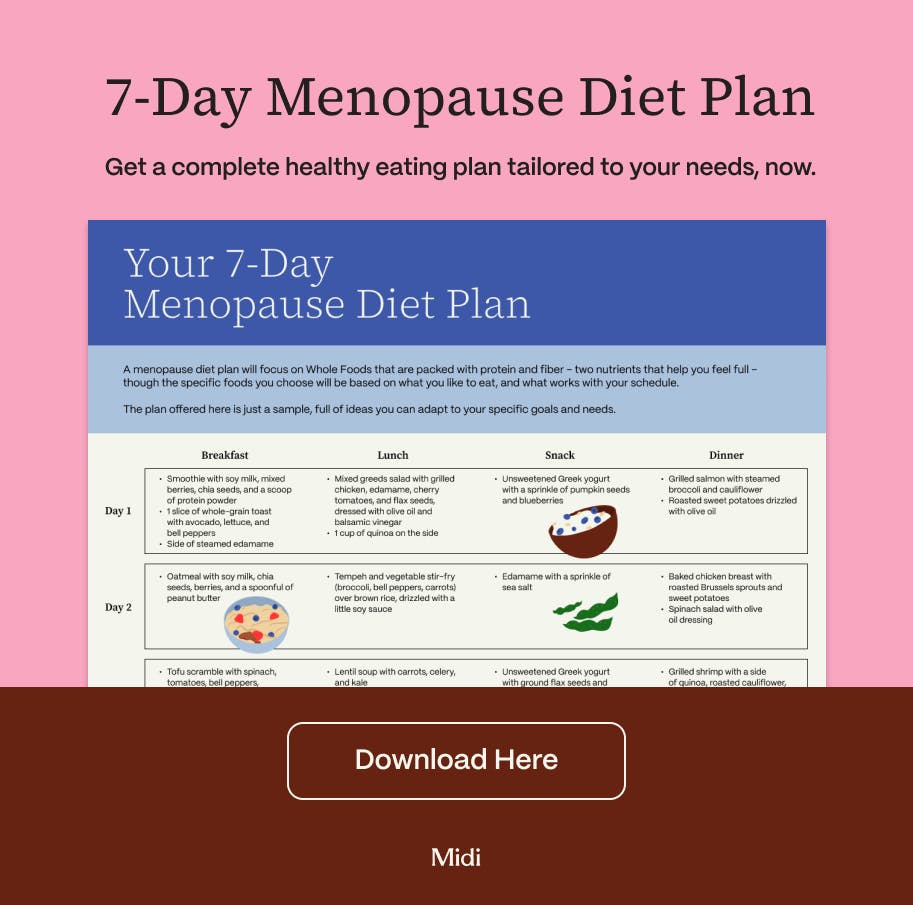Estrogen is a key female hormone, so when levels decrease during the menopausal transition, your body definitely feels it. Symptoms of low estrogen include hot flashes, but there are also sneakier ramifications of estrogen depletion, including an increased risk of osteoporosis and heart disease. When it comes to how to increase estrogen naturally, eating estrogen-boosting foods and following healthy lifestyle habits can make a big difference in how you feel—no gimmicks necessary.
Consider this: You have more than 50 hormones orchestrating your body’s daily functions. When things are going well, it’s like a symphony. But when you head towards menopause, well, things get out of tune a bit. (Okay, sometimes a lot.) One of those hormonal shifts? Estrogen, which begins its great descent as you close out your reproductive years. Catch is, this loss of estrogen can trigger a whole lot of strife for your body, causing common symptoms like hot flashes, vaginal dryness, mood swings, brain fog, and many more.
Many women opt to use hormone replacement therapy (HRT) to supplement some of the lost estrogen and calm these symptoms. But there are also natural ways to boost your estrogen levels, which can be used in conjunction with, in lieu of, or before prescription hormone therapy. Here’s what to eat and what to do (and avoid) to support healthy, feel-good hormone levels.
Understanding Estrogen and Its Importance
In order to understand how to increase estrogen, you first need to have a clear understanding of this powerful hormone’s role in your body. Let’s get into it.
What Is Estrogen?
Estrogen is a group of female sex hormones: estrone, estradiol, and estriol. We have estrogen receptors all over all bodies, so it should come as no surprise then that the hormone has far-reaching impacts, including:
- Supporting sexual development and pregnancy
- Preserving the health of vaginal tissue
- Aiding in bone growth and strength
- Protecting your cardiovascular system
As women age, estrogen naturally declines during the perimenopausal and menopausal years, settling into its lowest levels post-menopause.
Health Benefits of Maintaining Estrogen Levels
Yes, the hormone helps keep your cycle regular and the tissues of your vagina plump and properly hydrated, but estrogen has other head-to-toe benefits, including:
- Maintains heart health by helping regulate blood pressure, supporting healthy lipid (cholesterol, triglyceride) levels, and may decrease the risk of heart disease.
- Sharpens your cognitive well-being by promoting mental clarity and memory.
- Preserves muscle mass (a boon for maintaining a healthy metabolism and weight).
- Keeps bones strong to guard against osteopenia and osteoporosis.
- Promotes a more stable mood.
- Reduces the severity of many symptoms of menopause, such as hot flashes and night sweats.
How to Increase Estrogen with HRT
Now that you know just how impactful estrogen is for your body, the question you may be asking yourself is, how can I maintain healthy estrogen levels? Many women opt to use hormone replacement therapy (HRT), also referred to as hormone therapy or menopausal hormone therapy (MHT).
This medication, available in various forms from pills to patches to gels, does not replace all of your estrogen as the name suggests, but instead supplements some of the estrogen that your body is missing. Adding even a small percentage back can lead to drastic improvements in symptoms.
But HRT isn’t the only solution—a healthy lifestyle with targeted dietary changes, exercise, sleep, stress management, and reduced endocrine disrupters can all help optimize natural levels while also helping with managing the symptoms of estrogen depletion that occur in midlife.
Working with a healthcare professional who is knowledgeable about menopause, like a Midi clinician, can help you determine if HRT is right for you.
Natural Ways to Increase Estrogen
Dietary Changes to Boost Estrogen
When you’re looking for natural estrogen boosters, start with foods rich in estrogen-like compounds, referred to as phytoestrogens or isoflavones. Best of all, these are nutritious adds to your diet that can benefit your health in more ways than one.
Phytoestrogen-Rich Foods
Phytoestrogens are plant compounds that may have estrogen-like properties. They’re found in certain legumes, fruit, vegetables, and grains. There are generally three main types:
- Isoflavones: Derived from soy-based foods like tofu, miso, and soybeans like edamame.
- Lignans: Derived from foods like flax and sesame.
- Coumestans: Derived from peas, beans, and alfalfa sprouts, but many of these compounds do not have estrogen properties.
Consuming phytoestrogens can help address the challenges that come with estrogen depletion—things like osteoporosis, cognitive dysfunction, breast cancer, and may benefit cardiometabolic health—plus, they may help relieve some of the symptoms of menopause. Good sources of these phytoestrogens include:
- Flaxseeds: Rich in lignans, consuming flax may alter estrogen levels and metabolism in a way that may even be helpful for breast cancer prevention.
- Soy-based foods: Tofu, tempeh, soy milk, and edamame contain isoflavones. A review and meta-analysis in Advances in Nutrition found that soy intake affects estrogen in a beneficial and safe way. Consuming soy was not found to affect markers of estrogen-related cancers (a common fear), as these isoflavones act differently from the estrogen produced in the body. At the same time, previous research has found that isoflavones may help alleviate menopause symptoms, reduce bone loss, and improve memory.
- Garlic: May contain compounds that help regulate hormone levels, though more data is needed. Garlic can also support heart health by lowering cholesterol and reducing blood pressure.
- Fruits and vegetables: Fruits and veggies also contain lignans, though these are in lower amounts compared to flax. Some sources are better than others, such as broccoli and Brussel sprouts in the veggie category and apricot, pear, and grapefruit in fruits. Rather than focusing on specific ones, aim to get a variety of fruits and veggies in your diet.
- Legumes: Beans, peas, lentils…they’re all types of legumes, which are a significant source of phytoestrogens, specifically isoflavones. Eating higher amounts of legumes was linked to less severe menopause symptoms, like hot flashes and sweating, according to research on midlife women in Frontiers in Endocrinology. According to the data, you should aim to eat legumes at least three times per week.
More Estrogen-Supporting Foods
While these aren’t considered foods high in phytoestrogens, they do support overall hormonal health:
- Nuts and seeds: Whether you like almonds, cashews, walnuts, or pumpkin seeds, nuts and seeds are a great addition to a menopause diet, as their unsaturated fat, plant compounds, and fiber reduce inflammation and belly fat and promote a healthy gut microbiome.
- Cruciferous vegetables: Broccoli, Brussels sprouts, and cauliflower contain isothiocyanates, plant chemicals that may affect estrogen metabolism (among other functions) and decrease the risk of ovarian cancer.
- Fatty fish: Consuming polyunsaturated fats found in fish (such as EPA and DPA) has been associated with increased estradiol levels in women, plus these good-for-you fats are also anti inflammatory, heart-healthy, and may help decrease the risk of breast and endometrial cancers.
Lifestyle Modifications to Support Estrogen Production
The good news is that the things that are constantly recommended by experts for improving your all-around health also support estrogen production and overall metabolism. Here are the heavy hitters to focus on:
Exercise and Stress Management
Regular physical activity does a few things. First, a well-rounded exercise routine—that is, one including both aerobic and strength training—has been shown to improve estradiol levels among postmenopausal women with osteoporosis after 12 weeks.
Additionally, exercise can help counteract some of the health problems associated with estrogen loss in midlife. Aerobic exercise improves heart health to reduce the risk of cardiovascular disease, and research has found that it impacts hormonal health in other heart-protective ways. And exercise builds muscle, strengthens bones, and encourages a healthy weight, all of which decrease the risk of issues that tend to tag along with menopause like osteoporosis and metabolic disease.
And finally, exercise itself is a stress-buster, but if you want to have an extra impact, you can also add yoga, tai chi, or Pilates. These activities can help tame cortisol levels, which disrupt hormonal health.
One thing to keep in mind: Don’t wait to feel better or for your hormone levels to improve to exercise. One clinical trial in the journal Menopause found that hormone therapy does not lead to an increase in physical activity in menopausal women. Point being, the time to start exercising is now because it’s something that will help you feel better today.
The Role of Sleep in Hormonal Health
During menopause, any good sleep habits you developed over the years can get thrown out the window, given 60% of postmenopausal women report disrupted sleep. Blame estrogen loss here (plus stress, life changes, and everything else you have going on).
And, as anyone who’s had a terrible night of Z’s knows, poor sleep then causes a whole lot of problems like brain fog and mood swings. Sleep affects everything, from how well you can follow a balanced diet and manage stress to having the energy to exercise. So, to the best of your ability, prioritize seven to nine hours of quality sleep. Your prize? More stable hormones.
Reducing Exposure to Endocrine Disruptors
Real talk here: Endocrine-disrupting chemicals (EDCs) are everywhere. These are chemicals like phthalates, pesticides, flame retardants, and toxic metals used in the products we eat, drink, apply, and breathe in every day. EDCs dysregulate estrogen and thyroid hormones, among other problems caused by these chemicals. Some ways to decrease your exposure, per the National Institutes of Health:
- Drink filtered water
- Eat more whole fresh foods you cook at home
- Reduce dust in your home
- Use fewer personal care products
- Cut down on screen time
Supplements and Herbs to Support Estrogen Balance & Relieve Menopausal Symptoms
When you work with a menopause specialist, like a Midi clinician, to put together an individualized Care Plan, they may include botanical or vitamin and mineral supplements in your regimen.
Herbs That May Boost Estrogen Naturally
Although there is less data on herbals, they may be useful in supplementing a hormone-supporting healthy lifestyle. Midi clinicians may recommend botanical therapies like black cohosh (a flowering plant that helps relieve hot flashes), siberian rhubarb (a phytoestrogen-rich plant), or maca root (a root from Peru that helps the body better manage stress).
Key Vitamins and Minerals
Overall, a balanced, plant-based diet will provide the nutrients your body needs to support your hormones. In certain instances, your clinician may recommend taking a supplement.
- Vitamin D: Vitamin D is considered a hormone itself. It’s important for muscles, bones, cardiometabolic health, as well as alleviating symptoms of menopause and the genitourinary syndrome of menopause. Plus, low vitamin D has been linked to lower estrogen levels in women.
- Omega-3 fatty acids: Needed for cardiovascular and hormonal health.
- B vitamins: You need your B’s to break down the food you eat and turn it into energy, and support estrogen metabolism and function.
- Calcium: Assists in estrogen metabolism to help keep your skeleton strong, according to research on post-menopausal women. (That data suggests that food sources of calcium are best.)
- Magnesium: This mineral is involved in your body’s stress response and helps support more restful sleep. In a cruel twist, being under stress depletes magnesium in your body, making you even more susceptible to stress. Unfortunately, we may become deficient in magnesium during the menopausal years.
The Role of Probiotics in Hormone Balance
Probiotics are live bacteria like Lactobacillus and Bifidobacterium that can help populate your gut and promote a balanced, diverse microbiome, which is linked to benefits like digestive health. What’s more, your microbiome also plays an important role in estrogen metabolism. Research indicates that menopause is associated with an imbalance of bacteria in your gut, mouth, and vagina. One possible addition to your menopause symptom-fighting toolkit: an oral probiotic supplement or probiotic-rich foods. (Another convo to have with your clinician.)
Taking probiotic supplements is generally safe for healthy adults. Although research is limited in this space, oral formulas containing specific Lactobacillus strains—casei, helveticus, rhamnosus, and reuteri—may promote vaginal, bone, and cardiometabolic health, three areas that need a little help in the midlife years. You can take probiotics in supplement form (talk to your doctor about what formula they recommend for you), but probiotics also exist naturally in fermented foods like kefir, kimchi, yogurt, and kombucha.
Monitoring Estrogen Levels and Health
Every woman will go through menopause. While it’s natural for your body to lose estrogen during these years and it’s normal that you have symptoms as a result, you do not need to accept this as your new reality. And you don’t need to go it alone.
When to Seek Medical Guidance
If terrible periods, agonizing hot flashes and night sweats, wild mood changes, cognitive sludge, and other menopause symptoms are impacting your daily life, talk to a menopause specialist. Sometimes, lifestyle measures don’t do the job on their own, and your clinician may add more to your care plan, such as HRT as well as vitamin/mineral and herbal supplements. For the best chance at success, see a clinician, like one at Midi, who is a knowledgeable expert in menopause and its challenges to draw up an individualized plan to meet your needs.
Regular Health Check-Ups
Keep in mind that what your body needs at the start of perimenopause will likely change as you march through this transition. Adjusting your care plan throughout your midlife years is the best way to ensure that you’re getting what you need (and ditching what you don’t) to manage low estrogen levels and feel your best.
Key Takeaways
- Estrogen is a group of hormones: estrone, estradiol, and estriol. Estrogen levels naturally decline during the menopausal transition.
- Supporting proper estrogen production and metabolism through diet and lifestyle habits may help increase estrogen naturally.
- In some instances, your clinician may recommend supplements like black cohosh or siberian rhubarb, as well as vitamins and minerals like vitamin D and magnesium when needed to help alleviate symptoms of low estrogen.
- When natural solutions to low estrogen aren’t enough, you may want to consider prescription solutions like hormone replacement therapy (HRT).
If you’re in perimenopause or menopause and want guidance from clinicians who specialize in women’s midlife health, book a virtual visit with Midi today.
Hormonal change is at the root of dozens of symptoms women experience in the years before and after their period stops.
Our trained menopause specialists can help you connect the dots to guide you towards safe, effective solutions.
Whether you need personalized guidance or a prescription routine to tackle symptoms—including vaginal dryness and irritation, brain fog, hot flashes, sleep trouble, mood swings, and weight gain—we’ve got you covered.
Midi’s mission is to revolutionize healthcare for women at midlife, wherever they live and whatever their health story. We believe that starts with education, to help all of us understand our always-changing bodies and health needs. Our core values guide everything we do, including standards that ensure the quality and trustworthiness of our content and editorial processes. We’re committed to providing information that is up-to-date, accurate, and relies on evidence-based research and peer-reviewed journals. For more details on our editorial process, see here.













